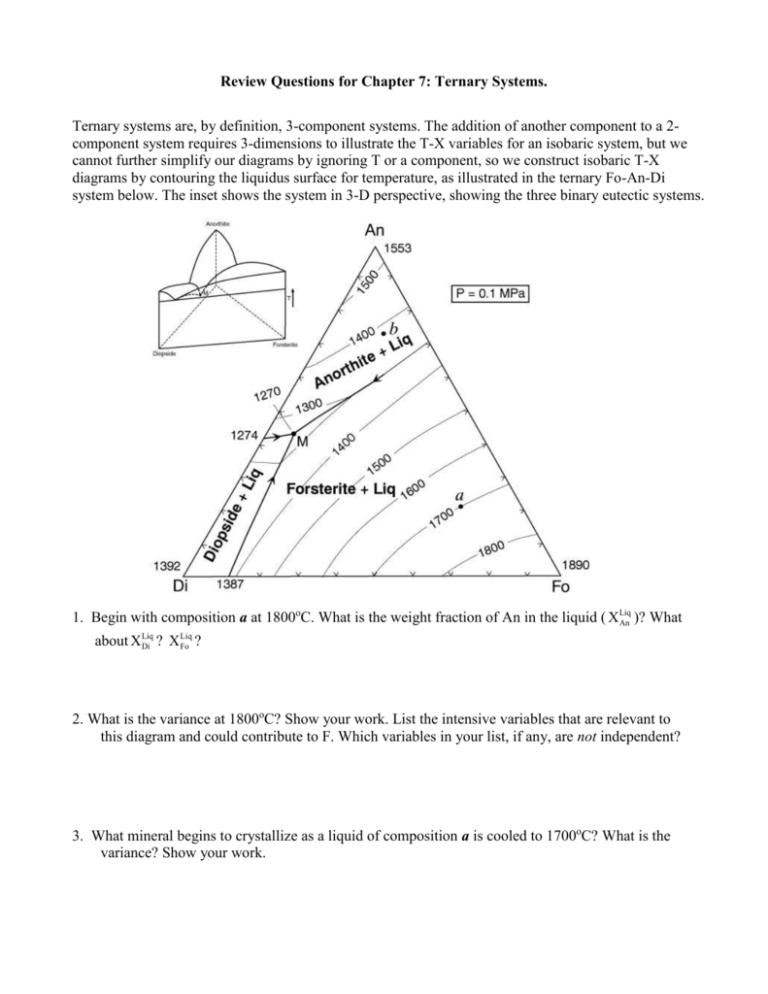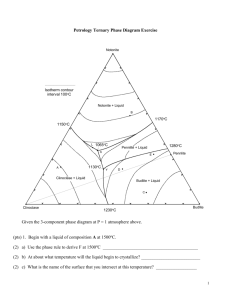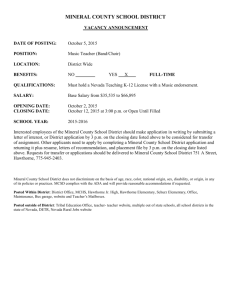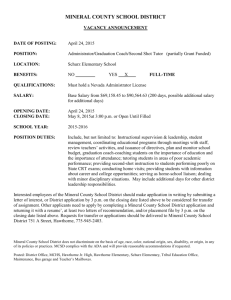Chapter 07
advertisement

Review Questions for Chapter 7: Ternary Systems. Ternary systems are, by definition, 3-component systems. The addition of another component to a 2component system requires 3-dimensions to illustrate the T-X variables for an isobaric system, but we cannot further simplify our diagrams by ignoring T or a component, so we construct isobaric T-X diagrams by contouring the liquidus surface for temperature, as illustrated in the ternary Fo-An-Di system below. The inset shows the system in 3-D perspective, showing the three binary eutectic systems. 1. Begin with composition a at 1800oC. What is the weight fraction of An in the liquid ( X Liq An )? What Liq about X Liq Di ? X Fo ? 2. What is the variance at 1800oC? Show your work. List the intensive variables that are relevant to this diagram and could contribute to F. Which variables in your list, if any, are not independent? 3. What mineral begins to crystallize as a liquid of composition a is cooled to 1700oC? What is the variance? Show your work. 4. Illustrate with a dashed line labeled “4” the “liquid line of descent” as the liquid continues to cool below 1700oC. Why does it move in the direction you have indicated? 5. What is the “continuous reaction” involved that permits the liquid composition to change? 6. Indicate with an “6” the point along the liquid line of descent where a new phase begins to crystallize. What phase is it? 7. Derive the variance at this point and show your work. 8. Show with a heavy line and an “8” the liquid line of descent from the point at which the new phase in part (6) formed. Write the new continuous reaction responsible for the change in liquid composition. 9. Choose a point along the cotectic between (6) and point M and show how you derive the bulk solid extract crystallized from the liquid at that point. How does that bulk solid extract differ from the total amount of solid crystallized? 10. Determine a general geometric rule relating the bulk composition to the compositions of the three phases that compose it (liquid, forsterite, and anorthite). 11. Will the liquid line of descent reach point M under equilibrium conditions? Why or why not? 12. If the liquid reaches point M, what occurs there? What is the variance for a system in which the liquid reaches point M? Show your work. 13. What is the final crystallization reaction? Is it a continuous or discontinuous reaction? Explain. 14. What was the sequence of minerals that formed for the liquid of composition a? 15. What sequence of minerals would form for a liquid of composition b? 16. Show in colored or labeled lines the liquid lines of descent for the crystallization sequence: c. Fo-Di-An d. Di-An-Fo e. Di-Fo-An f. An-Di-Fo 17. What would be the composition and temperature of the first partial melt of any mixture containing Fo+An+Di? 18. Outline as completely as you can the perfect partial melting (removing each increment of melt as it forms) of an initial mixture of Di + An + Fo in the proportions equivalent to point a in the diagram. The ternary Fo-An-SiO2 system at atmospheric pressure is shown below (without the temperature contours). The inset is a “chemographic” diagram showing the position of all solid phases with “tielines” connecting phases that can stably coexist together. You can use this insert to determine the final equilibrium mineral assemblage. For example, most bulk compositions in the Fo-An-SiO2 system will fall within the En-An-Q triangle with the remainder in the Fo-En-An triangle. These then represent the final solid 3-phase assemblages of any rock plotting within the respective triangle. Only rarely will a bulk composition plot on a 2-phase tie-line or a 1-phase point (also reducing the components). 19. Suppose a bulk composition does plot on the An-En tie-line. What will be the low-T mineral assemblage and what would be an appropriate choice for the components of such a system? Why? 20. Begin with composition a. What will be the final mineral assemblage? Why? 21. Derive the variance at a temperature above the liquidus. Show your work. 22. What will be the first mineral to form? Determine F when that occurs and interpret its meaning for an isobarically cooling magma. 23. Draw the liquid line of descent as the mineral crystallizes. What continuous reaction is occurring? 24. What happens when the liquid reaches the cotectic? Be specific. Derive and interpret the variance for the new phase-assemblage. 25. What continuous reaction is responsible for the evolution of the liquid composition along the cotectic curve. 26. Determine the bulk solid extract composition for the initial evolution of the liquid along the cotectic and use the lever principle to compute the ratio of Fo/An crystallizing. 27. Bearing in mind your answer to question 20, how can you be sure that the liquid cannot be completely crystalline before reaching point x? 28. Explain the change in the number of phases that occurs at point x. Derive the variance. An 29. Note that a tie-line connecting Fo-Liq(x) crosses one connecting AnEn. Note also that Fo + Liq may be combined in appropriate proportions to create a system of composition z (see right). Likewise En + An may be similarly combined to produce z. Use these observations to propose a geometric method for deriving the discontinuous reaction that must occur. L z Fo En 30. Is the reaction you derived a eutectic-type reaction (solids liquid) or a peritectic-type [solid(s) + liquid solid(s)]? Is point x, then, a ternary peritectic or eutectic point? 31. Noting where Xbulk plots in the figure with Question 29, which phase will be consumed first by the reaction? Explain. 32. Describe the remaining phase assemblage and derive the variance. 33. Begin with a liquid of Xbulk = b. What will be the final mineral assemblage? Why? 34. Outline the phases that form and the liquid evolution until it reaches point x. 35. Repeat the process of Question 31 for this bulk composition. 36. Will the liquid evolve to point y or crystallize first? Explain. 37. Determine the continuous reaction responsible for the evolution of the liquid composition between points x and y. 38. What new phase will form when the liquid reaches point y? Derive the variance. 39. Construct a geometric diagram similar to the one in question 29 and use it to propose a purely geometric method for deriving the discontinuous reaction that must occur at point y 40. What phase will be consumed first? What is the remaining phase assemblage and the variance? 41. Begin with a liquid of Xbulk = c. What will be the final mineral assemblage? Explain. 42. What is the first mineral to form? Derive the variance at this point. 43. Show the liquid line of descent until the liquid reaches the peritectic curve. Why does it follow the path you have indicated? 44. What new mineral forms when the liquid reaches the peritectic curve? Derive the variance. 45. As the liquid follows the peritectic, does the bulk solid extract point lie between Fo and En or En and Qtz? Why is this a problem if the system consists of forsterite, enstatite, and liquid? 46. The only solution to the conundrum is that the bulk solid extract (BSE) cannot consist of Fo + En (as it would if the bulk solid extract point had fallen between them). The BSE must consist of En and (-) Fo (negative forsterite) because the BSE composition is on the negative Fo side of En. In other words, the continuous reaction as the liquid evolves along the curve is not LiqA En + Fo + LiqB, but rather what? 47. Why must the liquid composition reach point x with further cooling? 48. What mineral forms when the liquid reaches x and what is the variance? What is the reaction and is it continuous or discontinuous? Why? 49. Will the liquid composition reach point y? Why or why not? 50. A liquid of Xbulk = d has an interesting variation on the evolution path described above. As with Xbulk = c, forsterite forms first, followed by enstatite as the liquid composition reaches and evolves along the peritectic curve. Note, as deduced previously, that the Xbulk always lies within the triangle with corners equal to the three coexisting phases. In other words, the whole must lie within the geometry of the parts. But at some point along the peritectic En-Xbulk-Xliq become collinear so that the Xbulk lies on the edge of the 3-phase triangle, not within it. How much forsterite can remain from the reaction you proposed in question 46? Explain. 51. What is the new phase assemblage and variance after that? 52. On the basis of your answers to Question 50, what is the new continuous reaction and liquid evolution path immediately after Fo disappears? Explain. 53. Outline the remainder of the liquid evolution until the system is completely solid. At what point do new minerals form, and what are they? What is the variance at each stage, and what reactions occur. Are the reactions continuous or discontinuous? 54. Outline the liquid evolution of Xbulk = e from the moment a solid forms until the system is completely solid. At what point do new minerals form, and what are they? What is the variance at each stage, and what reactions occur. Are the reactions continuous or discontinuous? 55. If a liquid of Xbulk = c crystallizes under equilibrium conditions, what will be the mineralogy of the final rock? Determine the minerals and their relative weight proportions. Clearly show your work, showing what you measured as well as your calculations. 56. If a liquid of Xbulk = c fractionally crystallizes, what will be the mineralogy of the final rock (simply estimate the proportions)? Explain your reasoning. 57. What phases are present and what is the variance for the following bulk compositions in the isothermal-isobaric phase diagram Fig. 7.9 (on right). Phases F a. Ab40-An40-Di20: b. Ab5-An90-Di5: c. Ab80-An5-Di15: d. Ab20-An20-Di60: e. Ab5-An35-Di60: 58. At any particular pressure, what governs the sequence of minerals that crystallize from a cooling melt? 59. Given your answer to question (58), evaluate the strengths and weaknesses of Bowen’s Reaction Series. 60. What is the general effect of increasing pressure on the melting point of a solid? Why is that so? 61. What would be the T and X effect of changing pressure on the eutectic point between minerals A and B if mineral A has a higher coefficient of compressibility? 62. Imagine the reaction A + B = C involving anhydrous minerals. If mineral B is the only one that can hydrate, describe the effect of adding H2O to the system. How does the reaction change? Use Le Châtelier’s Principle to describe how equilibrium would shift in response to adding more H2O, and the effect this would have on the position of the equilibrium reaction curve on a P-T phase diagram. Sketch the hydrous reaction curve on the accompanying hypothetical phase diagram. 63. Use the same reasoning to explain the effect of H2O on the melting temperature of a silicate mineral. 64. Use Le Châtelier’s Principle to explain why the effect of H2O on melting temperature is greater at high pressure than at low pressure. 65. Use the Clapeyron equation to explain the curvature of the H2O-staurated melting curve in Fig. 7.19 (right). 66. What is the major conclusion you can draw about the effect of H2O on melting and the amount of melt generated from the discussion of heating of H2O-undersaturated rocks in association with Fig. 7.22 (right)? 67. What are the major conclusions you can draw about the effect of H2O on a rising H2Oundersaturated magma in association with Fig. 7.22? PROBLEM 1. Ternary Phase Diagram Exercise P = 0.1 MPa Given the 3-component phase diagram at P = 1 atmosphere above. (pts) 1. Begin with a liquid of composition A at 1500oC. (2) a) Use the phase rule to derive F at 1500oC __________________________________________ (2) b) At about what temperature will the liquid begin to crystallize? __________________________ (2) c) What is the name of the surface that you intersect at this temperature? __________________ (2) d) What mineral forms at this temperature? _________________________________ (5) e) Draw the liquid line of descent in red on the diagram until the next phase begins to crystallize. Why does it move in the direction you indicated and what is the reaction responsible? (3) f) Is the reaction continuous or discontinuous? Explain. (2) g) At ~ what temperature does the next phase begin to crystallize? ______________________ (2) h) What is the phase? _________________________ (2) i) What is the name of the curve that you intersect at this point? ____________________ (3) j) Use the phase rule to derive F at this point ____________________________ (5) k) As it would apply to this particular situation, what does the diagram and your value of F in part (j) tell you about how the compositions of each phase behaves with cooling? (i.e. which diagram intensive variables are likely to be independent, and which dependent? Which can vary and which are fixed?). (2) l) Draw the liquid line of descent in blue as it would continue for this liquid. (4) m) What is the ratio of solid phases in the “bulk solid extract” that is crystallizing from the liquid at the moment it reaches point L? Show and label your construction lines (do it in sharp pencil). Sketch the lever below with the same labels as on the figure above. Include your measurements and your calculations. (7) n) An instant before the liquid first reaches point Y what are the proportions of the three coexisting phases at this temperature? Express the proportions as percentages, and show your work, clearly labeled as in part (m). (2) o) What happens when the liquid first reaches point Y? _________________________________ (2) p) What is the name of point Y? ___________________________________ (4) q) Determine F from the phase rule and interpret its meaning as it applies to the situation in (o). (5) r) Use the geometry of the phases coexisting at Y to determine the reaction that occurs. Explain your reasoning. (3) s) Is the reaction continuous or discontinuous? Explain. (4) t) When will the reaction be complete? What will be the first phase consumed? How do you determine this? (2) u) Will the liquid continue to evolve toward point X? Why? (5) v) What proportion of the crystallization of the original liquid occurred prior to 1130oC and what proportion occurred at the single temperature 1130oC? Be specific. (5) w) What are the approximate proportions of the minerals in the final rock (as %)? Show your work. (2) x) How will fractional crystallization affect the liquid evolution curve? Explain. (3) y) How will fractional crystallization affect the mineral composition of the final rock? Be specific. 2. Heat a solid rock of composition B (and assume equilibrium melting). (2) a) At what temperature will the rock begin to melt. Explain. (5) b) Write the reaction that takes place at this temperature and explain how you determined it on the basis of the phase geometry. Is the reaction continuous or discontinuous? Why? (4) c) Which phase will be the first one consumed, and how did you determine this? (1) d) Draw in green the path the liquid follows from the initial composition until it reaches about 1080oC. (2) e) Use the phase rule to determine F as the liquid follows the path that you have just drawn. (3) f) What is the continuous reaction that occurs along this path? ____________________________ (5) g) At what temperature will one of the reactants in (f) be consumed, and which one will it be? How can you determine this? Show and label any required construction lines on the diagram. (2) h) Draw the rest of the liquid path in orange until the system is completely liquid. At what temperature is melting complete? ________________________________ (6) 3. a) If perfect partial melting occurs for composition B, and each increment of melt created is removed, what will happen between 1065oC and 1100oC? Why? (4) b) After leaving point X, what is the next melt composition, and at what temperature does it occur? Explain. (3) c) What is the melt-producing reaction in part (b)? Is the reaction continuous or discontinuous? Why? (2) d) At what point does melting in the situation (b) cease? (5) e) What is the composition of the next melt increment, and at what temperature does if occur? 4. Begin with a melt of composition C. (2) a) At what temperature does the melt begin to crystallize? _________________________ (2) b) What is the first mineral to appear? ______________________________ (2) c) Draw the liquid evolution curve in yellow from the point of first crystallization until a new phase forms and explain your choice of paths. (2) d) What is the next phase to form? _________________________ (2) e) At what temperature does it form? _______________________ (3) f) What is the continuous reaction that occurs along the curve toward point Y? (2) g) What happens when the liquid composition first reaches point Y? (4) h) What is the discontinuous reaction that occurs at point Y? Explain how you determined this on the basis of the phase geometry. (2) i) What phase will be the first to be consumed? Explain your reasoning. (3) j) Will the liquid composition leave point Y? Y or Y not? 5. Cool a melt of composition D. (2) a) At what temperature will the first mineral crystallize? _________________________ (2) b) What mineral will it be and how did you determine this? (2) c) Draw the liquid line of descent in purple from this point until the next phase forms and explain your choice of paths. (4) d) What is the next phase to crystallize, and at about what temperature does it form? (5) e) What will be the continuous reaction that occurs as the liquid evolves toward point Y, and how do you determine this? (2) f) What is the discontinuous reaction at point Y? (2) g) Use the phase rule to derive F at this point. ________________________________________ (5) h) What will be the first phase to disappear at point Y? Will the liquid leave point Y with further cooling? Will it reach point X? Explain. (3) i) What will be the continuous reaction that occurs after the liquid leaves point Y? Explain how you determined this. (2) j) What will happen when the liquid reaches point X? (4) k) Show how you use the phase geometry to determine the reaction that occurs at X. (2) l) At what temperature will the last of the liquid crystallize? ______________________ (3) m) What will be the approximate proportions of the minerals in the final rock? 6. Begin with a liquid of composition E. (2) a) At what temperature will the first mineral crystallize? _________________________ (3) b) What mineral will form and how did you determine this? (2) c) Draw the liquid line of descent in light green from this point until the next phase forms. (4) d) What is the next phase, and at about what temperature does it form? ____________________ (2) e) What will be the continuous reaction that occurs as the liquid evolves toward point Y. (5) f) At what point will this liquid leave the peritectic curve? Show your construction lines and explain their significance. What phase is consumed when this occurs? How do you know? (2) g) Draw the liquid line of descent in brown from this point until the next phase crystallizes. (4) h) What is the next phase to crystallize, and at about what temperature does this occur? (2) i) What will happen when the liquid reaches point X? (2) j) At what temperature will the last of the liquid crystallize? Explain. (3) k) What will be the approximate proportions of the minerals in the final rock?






